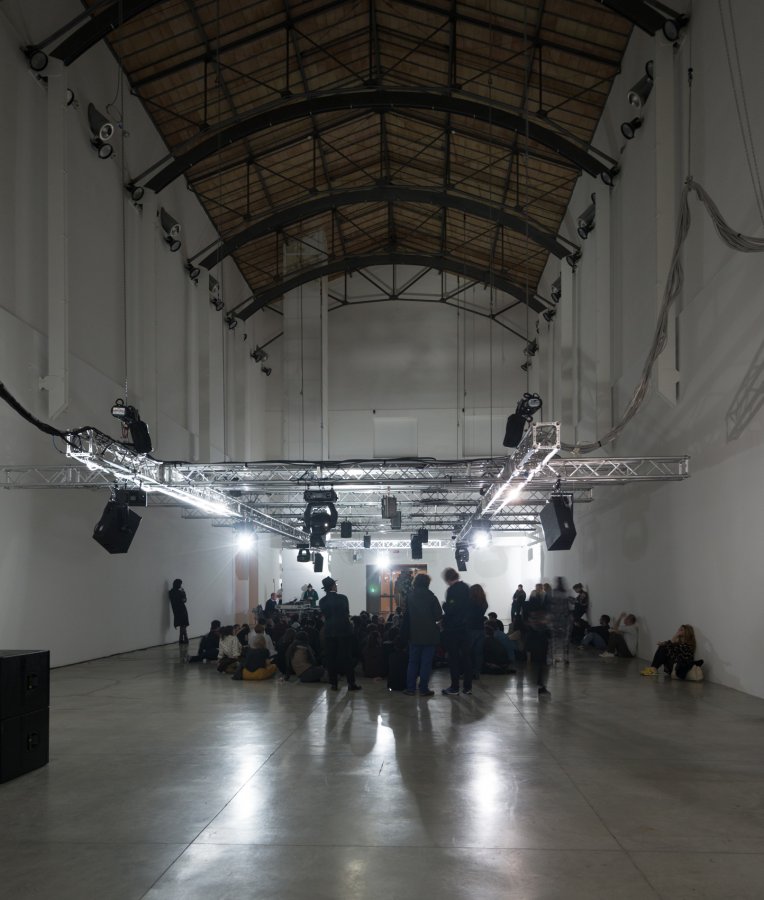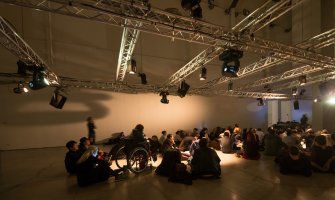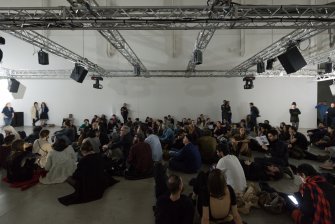Chimerization, Modulator, Synthetic Hinge
Florian Hecker
Live Arts Week presenta per la prima volta in Italia il trittico di Florian Hecker costituito dalle tre opere sonore Chimerization, Modulator e Synthetic Hinge. Un'occasione rara per seguire l'evoluzione del lavoro di uno tra i più importanti protagonisti della musica elettronica contemporanea, grazie alla mise-en-espace dei suoi ultimi capolavori su testo e suono di sintesi, creati all'interno di Chimerization, progetto di ricerca psicoacustica avviato al MIT-Massachusetts Institute of Technology nel 2011. Hecker utilizza il termine 'chimerizzazione' come nozione chiave per verificare un nuovo e rivoluzionario approccio compositivo. Decomponendo il suono per ottenere modalità di ascolto tra loro incompatibili, Hecker tende al superamento della caratteristiche timbriche specifiche di ogni fonte, per dare vita ad una chimera auditiva: un oggetto determinabile a partire da elementi prelevati dal processo originario, che si realizza solo grazie all'attività di sintesi percettiva dell'ascoltatore. Vi è un doppio spiazzamento che opera congiuntamente tra ciò che il suono dice sulla sua produzione materiale ('da che cosa') e ciò che indica della sua provenienza spaziale ('da dove'). In questa tensione, ciò che si ottiene non è esattamente un terzo e nuovo elemento di sintesi, ma una molteplicità aperta di possibilità di ascolto e attualizzazione. Qualcosa che, evocando il lavoro teorico di Quentin Meilassoux, ci introduce in un universo di pura contingenza. In questo sforzo di fondare su nuove basi l'esperienza e l'oggetto della pratica musicale, ci si inoltra su un terreno sospeso tra linguaggio e non-linguaggio, rasentando anche problematiche di natura ontologica. In questa sfida Hecker ha coinvolto il filosofo e narratore iraniano Reza Negarestani nella scrittura dei libretti, il cui testo oscuro ma non indecifrabile, recitato in una camera anecoica, è stato registrato e poi trattato attraverso una perturbazione algoritmica, costituendo la base di due delle composizioni eseguite nello spazio fisico di MAMbo, Chimerization e Synthetic Hinge.
Chimerization è il titolo dell'opera prodotta in occasione di Documenta 13-Kassel, che ha visto il primo coinvolgimento di Reza Negarestani per la stesura del testo The Snake, the Goat and the Ladder (A board game for playing chimera). Chimerization è stato registrato in uno spazio perfettamente insonorizzato per azzerare riflessi sonori e altre onde elettromagnetiche. Il materiale ottenuto (una sorta di popolazione di quantum bit vocali) viene gradualmente chimerizzato. Il contenuto testuale è mantenuto intelligibile, ed è a discrezione dell'ascoltatore seguirne il senso o assaporare la manifestazione puramente fenomenica.
Synthetic Hinge rappresenta un'evoluzione di Hinge (cerniera), installazione audio per tre canali, per la quale Hecker ha coinvolto come voce principale la leggendaria artista americana Joan La Barbara. Partendo anche in questo caso da un libretto scritto da Negarestani, Synthetic Hinge è una versione generata dal computer che trasforma la voce dal registro umano ad uno totalmente sintetico, dando luogo ad una nuova entità parlante. Questo fraseggio polarizzato può ricordare un certo minimalismo, ma qui è l'ascoltatore che costituisce la cerniera, come un pendolo che oscilla tra due obelischi, a destra e a sinistra, tracciando tra essi le due rotte chimeriche rappresentate da natura e cultura.
Modulator (... privo di senso, anaffettivo, proveniente dal nulla ...) celebra il concetto di suono in quanto essere Immateriale, tramite una sequenza di brevi episodi. L'attraversamento di diverse scale - dal basso verso l'alto, e dall'alto verso il basso - eccita la mente umana nella produzione allucinatoria di oggettualità, a partire da semplici segnali uditivi privati delle ovvietà compositive offerte da uno sviluppo narrativo.
multiple sound performance, prima italiana
ideazione, suono Florian Hecker
graphic design NORM
testi Reza Negarestani
presentato col sostegno di Goethe-Institut Mailand
Live Arts Week present three of Florian Hecker’s sound works. A unique occasion dedicated to his last masterpieces of text, sound and synthesis, with a sequential performance of Chimerization, followed by Modulator and Synthetic Hinge. The research project on Chimerization that Hecker initiated at the MIT Massachusetts Institute of Technology in 2011, starts from a concept derived from psychoacoustic investigations into the difficult-to-define areas between language and non-language. These investigations focus on the decomposition of sound and on synthesizing incompatible modalities, surpassing their respective particularities without fusing them, in order to obtain a narration beyond immediate comprehension, which may be deciphered through repeated, ‘active’ listening. For both Chimerization and Hinge finds Hecker teamed up with the Iranian philosopher Reza Negarestani. Hecker commmissioned Negarestani to write the experimental librettos for the works, which were recited and recorded in an anechoic environment, and then processed through an algorithmic perturbation. In the big hall of the museum Hecker creates a sort of pathway through which the works are being performed in a pandemic chimerization.
Chimerization is a text-sound piece produced for the occasion of the documenta 13 in Kassel, Germany. For Chimerization Hecker invited Reza Negarestani, to write a script, The Snake, the Goat and the Ladder (A board game for playing chimera), that has been recited by a group of speakers and recorded in anechoic and sound-attenuated chambers - rooms designed to minimize the reflections of either sound or electromagnetic waves.
Synthetic Hinge is a new sound operation on Hinge which featured the legendary artist Joan La Barbara as its main voice. In the reworking the piece is based on a computer generated version of La Barbara's voice, with a gradational shift from the human, chimerized voice into the completely synthetic, complicating any assimilation of their respective traits. The re-polarizing phrasings of Hinge recalls minimalist narratives. Here the listener may construct a hinge, a pendulation between the right and the left obelisks; embarking upon navigation and synthesis while tracing the chimeras of nature and culture.
Between these pieces, Modulator (... meaningless, affectless, out of nothing ...) reveals, in a structural and formal manner, the synthetic means of modulation and topological transformation. In a sequence of short episodes and chronics, Modulator celebrates the notion of sound as an Immaterial. Its syntheticness and modern generation is created by a bottom up and top down process across different scales, stimulating the human minds capacity to produce hallucinations of objects on the basis of auditory cues, without obvious compounding of a narrative progression.
multiple sound performance, italian première
concept, sound Florian Hecker
graphic design NORM
texts Reza Negarestani
presentation supported by Goethe-Institut Mailand



